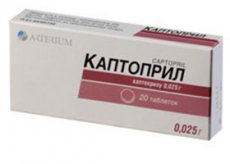Medical expert of the article
New publications
Preparations
Captopril
Last reviewed: 03.07.2025

All iLive content is medically reviewed or fact checked to ensure as much factual accuracy as possible.
We have strict sourcing guidelines and only link to reputable media sites, academic research institutions and, whenever possible, medically peer reviewed studies. Note that the numbers in parentheses ([1], [2], etc.) are clickable links to these studies.
If you feel that any of our content is inaccurate, out-of-date, or otherwise questionable, please select it and press Ctrl + Enter.

Indications Captopril
It is used mainly to prevent the development of hypertensive crisis and to lower blood pressure values. It is used for the following disorders:
- increased pressure inside the kidneys;
- primary hypertension (increased blood pressure of unknown origin);
- hypertension of a malignant nature (in the presence of resistance to other drugs).
 [ 7 ]
[ 7 ]
Release form
The element is released in tablet form (volumes of 12.5, 25, and also 50 or 100 mg). Inside the blister packs - 10 tablets. In the box - 2 packs.
Pharmacodynamics
The active component of the drug slows down the activity of ACE, preventing the transformation of angiotensin-1 into the 2nd form. Angiotensin-2 is the main element of the RAS structure, which has a significant vasoconstrictor effect. A decrease in angiotensin-2 indicators, a decrease in aldosterone production, and in addition, the accumulation of the vasodilating element bradykinin lead to the development of antihypertensive activity.
Captopril reduces systemic vascular resistance relative to blood flow, reduces pressure and afterload within the pulmonary circulation. Along with this, the drug can additionally reduce aldosterone values within the adrenal glands.
Pharmacokinetics
Approximately 75% of the active ingredient is absorbed at a fairly high rate inside the gastrointestinal tract. Eating food can reduce the degree of absorption by 30-40%. Blood Cmax values are determined after 0.5-1.5 hours. Synthesis of the active component with albumins is 25-30%.
Captopril is excreted in breast milk. Metabolic processes occur in the liver. Metabolic products have no medicinal activity.
Excretion of 95% of the drug is carried out by the kidneys (almost half of it in an unchanged state, and the remainder in the form of metabolic products).
In individuals with severe renal impairment, accumulation of the drug is observed.
Dosing and administration
The medication must be taken orally. The substance reduces blood pressure quite quickly. Only the attending physician can prescribe the medication.
When a hypertensive crisis develops, it is necessary to place a tablet with a dosage of 25 mg under the tongue - this leads to the rapid development of an antihypertensive effect.
Use Captopril during pregnancy
Contraindicated for use by pregnant women or while breastfeeding.
Contraindications
Main contraindications:
- aortic stenosis;
- Conn's syndrome;
- mitral stenosis;
- condition after kidney transplantation;
- stenosis affecting the renal arteries;
- tendency to develop edema;
- presence of severe sensitivity to the drug;
- myocardiopathy.
Side effects Captopril
The use of a therapeutic substance may provoke the appearance of certain side effects:
- nervous system disorders: dizziness, severe fatigue, paresthesia, asthenia and migraine headaches;
- disorders affecting the functioning of the cardiovascular system: orthostatic collapse or increased heart rate;
- digestive disorders: pain in the epigastric region, nausea, bowel disorders (constipation or diarrhea syndrome), taste bud disorders, as well as cholestasis, pancreatitis, increased AST, ALT or bilirubin levels, and hepatitis;
- problems with the hematopoietic system: anemia, agranulocytosis (if an autoimmune disease is present), neutropenia and a decrease in the number of platelets;
- metabolic disorders: acidosis or increased K+ values;
- urinary disorders: the appearance of protein in the urine and problems with kidney function;
- signs of allergy: presence of antinuclear antibodies, serum sickness, bronchial spasm, lymphadenopathy or Quincke's edema;
- Others: a dry, unproductive cough may be observed.
If the patient experiences other negative symptoms, he/she should consult a doctor and temporarily stop using the drug.
Overdose
In case of poisoning with the drug, a significant decrease in blood pressure indicators occurs. The disorder can be complicated by a disorder of the blood supply to the brain, thromboembolism, and myocardial infarction.
In such disorders, the victim should be laid horizontally and his legs should be raised. Also, to restore blood pressure values, an intravenous injection of physiological fluid is performed. The peritoneal dialysis procedure will be ineffective, but hemodialysis can give positive results.
Interactions with other drugs
When administered together with immunosuppressants or cytostatics, leukopenia may occur.
Combination with diuretics (potassium-sparing) may lead to hyperkalemia (spironolactone and amiloride with triamterene).
Azathioprine can cause anemia associated with the suppression of erythropoietin activity. There is information about the development of leukopenia caused by additive hematopoiesis in the bone marrow.
When combined with allopurinol, potentiation of hematological properties is possible.
Aspirin may reduce the antihypertensive effect of the drug.
The drug has the ability to increase digoxin levels. Drug interactions mainly develop in people with severe kidney disease.
Attention!
To simplify the perception of information, this instruction for use of the drug "Captopril" translated and presented in a special form on the basis of the official instructions for medical use of the drug. Before use read the annotation that came directly to medicines.
Description provided for informational purposes and is not a guide to self-healing. The need for this drug, the purpose of the treatment regimen, methods and dose of the drug is determined solely by the attending physician. Self-medication is dangerous for your health.

